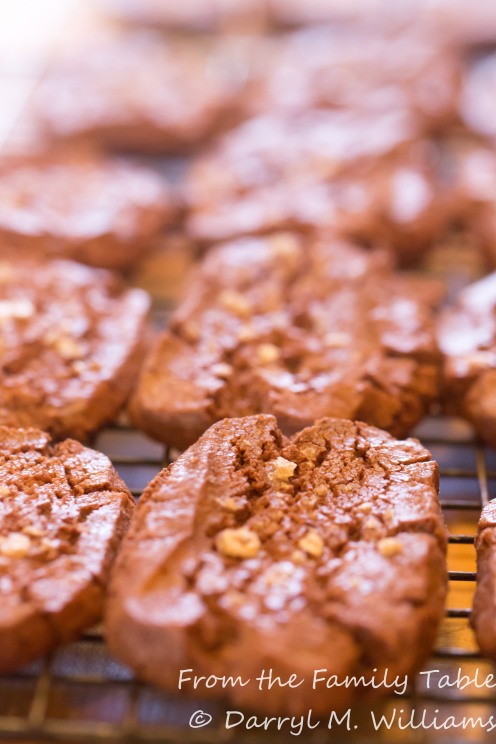Our local farmers market stays open all year, but only now have the growers occupied their open-air stalls. There is still wind and cold weather, so about the only things available are greens and a few root vegetables. One exception to that is the beautiful trumpet mushrooms available from the “mushroom man”. If you are like me, you wind up buying way more from the vendors than you can possibly use. I try to plan daily menus in my mind as I walk down the aisles. Invariably, my eyes and appetite fail me so that when the end of the week and a new farmers market arrives, there are things still in the vegetable crisper. The trumpet mushrooms fell into that category this week, so when I looked in the pantry and saw a container of Arborio rice, I immediately thought of risotto. I also wanted to try a new brand of boxed fish stock as well as Better Than Bouillon fish stock base suggested by my friend, Jim Hastings. It seemed like a perfect excuse for shrimp risotto. On top of all that, the stove top smoker was still sitting on the kitchen counter after my effort at smoked new potatoes, so the stars just seemed to come together for smoked shrimp with mushroom risotto.
RECIPES
Oak-Smoked Shrimp
Ingredients
- ¼ cup smoking chips
- 6 large (10-15/pound) per person
- Old Bay seasoning
- salt and pepper
Method
- Prepare stove top smoker by heaping special wood chips in the middle of the smoking pan. Cover the tray with aluminum foil to make cleanup easier and insert, along with rack in the smoker.
- Skewer 6 shrimp. Sprinkle with Old Bay seasoning, salt, and pepper. Place on the smoker rack, and close the top, leaving an opening of about 3 inches.
- Place the smoker over two burners of the kitchen range, both set to medium flame.
- When smoke begins to come out of the lid opening, close tightly and smoke for 20 minutes.
- Remove the smoker from the stove, open the lid, and remove the shrimp.If they do not appear to be done, replace the smoker lid and place over the flame for another 5 minutes.
Trumpet Mushroom Risotto
Ingredients
- 2 tablespoons olive oil
- ¼ cup shallot finely chopped
- 1 cup Arborio rice
- 2 quarts seafood stock made by dissolving 2 teaspoons Better than Bouillon fish stock base in 2 quarts water (or use canned fish stock or your own home-made fish stock diluted 1:4 with water)
- 1 pint container of trumpet mushrooms
- 2 tablespoons unsalted butter
- salt and pepper to taste
Method
- In a medium sauce pan with lid, heat the oil over a medium-low flame. Add the shallots and sweat, covered, for about 5 minutes.
- Add the rice, and raise the flame to medium, stirring constantly until the rice becomes opaque but does not brown.
- In the meantime, bring the fish stock to the simmer over another flame.
- Add one ladleful of stock to the shallot-rice mixture and raise the heat to bring to the boil.
- Stir frequently (constantly) until the liquid has almost completely evaporated. Then add another ladleful of the stock and again stir until nearly evaporated. Repeat the process until the fish stock is used up or the rice is creamy and tender, about 30 – 40 minutes . If you need more liquid to finish cooking the rice, use water.
- In the meantime, melt the butter in a small skillet over medium heat. Add the mushrooms and sauté for 5 minutes. Set aside.
- When you are ready to serve, stir the mushrooms into the risotto. Adjust the seasoning with salt and pepper. Top with the smoked shrimp and serve. There should be enough risotto for 2 to 4 persons, depending upon hunger.













![Panna Cotta[2]-2 A good-sized piece of ginger root](https://fromthefamilytable.files.wordpress.com/2014/05/panna-cotta2-2.jpg?w=162&resize=162%2C162&h=162#038;h=162&crop=1)
![Panna Cotta[2]-3 Pieces of ginger root simmering in the cream and sugar mixture](https://fromthefamilytable.files.wordpress.com/2014/05/panna-cotta2-3.jpg?w=162&resize=162%2C162&h=162#038;h=162&crop=1)
![Panna Cotta[2]-6 The finished dessert: ginger-scented panna cotta topped with cajeta and served with a sea-salt-sprinkled chocolate sablé](https://fromthefamilytable.files.wordpress.com/2014/05/panna-cotta2-6.jpg?w=162&resize=162%2C162&h=162#038;h=162&crop=1)





















